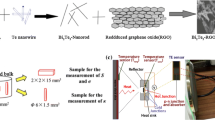Abstract
Heat is the most ubiquitous form of energy on planet Earth. Every day, the sun continuously strikes the Earth’s surface with 120,000 Terawatts of energy. This solar energy is more than 10,000 times the amount of energy produced worldwide. With the scarcity of fossil fuels looming on the horizon and its adverse effect on the environment many researchers, from academia to industry, are exploring cleaner, greener and more efficient renewable energy technologies. Thermoelectricity can provide an alternative to hazardous fossil fuels as its electricity is produced directly from heat with no moving parts or working fluid. The efficiency of any thermoelectric material is given by a quantity called the figure of merit ZT. For thermoelectric (TE) devices to be competitive with fluid-based and other energy related devices, ZT greater than 2 is usually sought. Here, we report on the fabrication of thin film thermoelectric materials based on Bi2Te3/WS2 superlattice layer structure using RF magnetron sputtering deposition method. Quantum confinement in these low dimensional and ultrathin superlattices can enhance the density of states near the fermi level resulting in higher ZT value. The thermoelectric figure of merit can be enhanced by controlling the layer thickness close to the phonons mean free path. This way heat carrying phonons with different wavelengths can be scattered efficiently resulting in lower lattice thermal conductivity.
Similar content being viewed by others
References
T. J. Seebeck, “Ueber den Magnetismus der galvenische Kette”. Technical report, Reports of the Royal Prussian Academy of Science, Berlin, Germany, (1821).
T. J. Seebeck, “Magnetische Polarisation der Metalle und Erze Durch Temperatur-Differenz (Magnetic polarization of metals and minerals by temperature differences)” 1822–1823 in Ostwald’s Klassiker der Exakten Wissenshaften Nr. 70 (1895)
E. Velmre, “Thomas Johann Seebeck (1770–1831)” Proc. Estonian Acad. Sci. Eng., 13, 4, 276–282 (2007)
J. C. A. Peltier, “Nouvelles Experiences sur la Caloricite des Courans Electriques (New experiments on the heat effects of electric currents)”. Annales de Chimie et de Physique. 56: 371–386. (1834).
C. Wood, “Materials for thermoelectric energy conversion” C Wood Rep. Prog. Phys. 51. 463 (1988)
W. Thomson, “One the Dynamical Theory of Heat. Trans.” R. Soc. Edinburgh: Earth Sci. 3, 91–98 (1851).
C. Goupil, W. Seifert, K. Zabrocki, E. Muller, and G.J. Snyder , “Thermodynamics of Thermoelectric Phenomena and Applications” Entropy, 13, 1481–1516 (2011) doi:10.3390/e13081481
R.R. Hea, H.Y. Zhonga, Y. Caib, D. Liub, and F.Y. Zhao, “Theoretical and Experimental Investigations of Thermoelectric Refrigeration Box Used for Medical Service” Procedia Engineering, 205, 1215–1222 (2017)
R.A. Taylor, and G. L. Solbrekken, “Comprehensive System-Level Optimization of Thermoelectric Devices for Electronic Cooling Applications” IEEE Transactions on Components and Packaging Technologies, VOL. 31, NO. 1, (2008)
M. S. Dresselhaus, G. Dresselhaus, F. Bitter, X. Sun, Z. Zhang, S. B. Cronin, and T. Koga, “Low-dimensional thermoelectric materials” Physics of solid state Vol. 41, Number 5 (1999)_
M. S. Dresselhaus, G. Chen, M. Y. Tang, R. Yang, H. Lee, D. Wang, Z. Ren, J.P. Fleurial, and P. Gogna, “New Directions for Low-Dimensional Thermoelectric Materials” Adv. Mater. 19, 1043–1053 (2007)
T. DeVoe, and S. Oh, “Properties of RF Sputter Deposited Bismuth Telluride Thin Films.” Conference Proceedings (2013)
G. J. Snyder, and E. S. Toberer, “Complex thermoelectric materials” Nature materials Vol. 7 (2008)
Z. Xin, X. H. Song, and Z. Dian-Lin, “Thickness dependence of grain size and surface roughness for dc magnetron sputtered Au films” Chin. Phys. B Vol. 19, No. 8 (2010)
P. Martin, Z. Aksamija, E. Pop, and U. Ravaioli, “Impact of Phonon-Surface Roughness Scattering on Thermal Conductivity of Thin Si Nanowires.” Phys. Rev. Lett. 102, 125503 (2009)
J. Lim, K. Hippalgaonkar, S.C. Andrews, A. Majumdar, and P. Yang, “Quantifying Surface Roughness Effects on Phonon Transport in Silicon Nanowires” Nano Lett. 12, 2475–2482 (2012)
Author information
Authors and Affiliations
Rights and permissions
About this article
Cite this article
Mbaye, M.T., Howe, A., Pradhan, S.K. et al. Growth Optimization of Multi-layer Thin Film Thermoelectric Materials based on Bi2Te3 / WS2 superlattice Structure. MRS Advances 4, 1709–1717 (2019). https://doi.org/10.1557/adv.2019.270
Published:
Issue Date:
DOI: https://doi.org/10.1557/adv.2019.270




